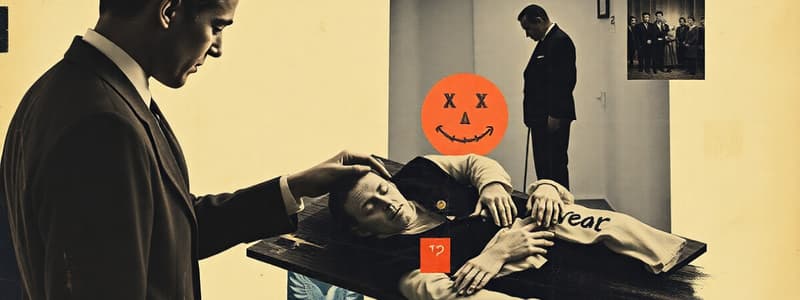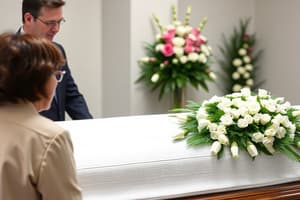Podcast
Questions and Answers
How does the funeral director's role resemble that of a theater director, and what aspects of the funeral can be considered part of a staged performance?
How does the funeral director's role resemble that of a theater director, and what aspects of the funeral can be considered part of a staged performance?
The funeral director controls the dramatic production. The funeral is a staged performance with backstage preparations, equipment, props, and a schedule of events.
In what ways are the bereaved considered 'supporting actors' in the funeral performance, and how might their behavior be judged by the 'audience'?
In what ways are the bereaved considered 'supporting actors' in the funeral performance, and how might their behavior be judged by the 'audience'?
The bereaved are part of the performance and their behavior is reviewed and judged. Comments on how well the family 'held up' are taken into account. Showing too little or too much emotion can lead to negative judgments.
Why might a minister be considered a 'potentially troublesome' cast member in a funeral, and what 'counter-reality' might they introduce?
Why might a minister be considered a 'potentially troublesome' cast member in a funeral, and what 'counter-reality' might they introduce?
A minister is potentially troublesome because they might construct a counter-reality that casts doubt on the show. This counter-reality is the idea that the body is a shell and the 'soul' has departed.
How do funeral homes use architectural design and decoration to establish meanings beyond death and morbidity?
How do funeral homes use architectural design and decoration to establish meanings beyond death and morbidity?
How does the funeral director use cues to help mourners understand what is expected of them during the funeral?
How does the funeral director use cues to help mourners understand what is expected of them during the funeral?
What role does music play in establishing the mood at a funeral, and how does it guide the audience?
What role does music play in establishing the mood at a funeral, and how does it guide the audience?
In what ways does the language used during a funeral contradict the objective of accepting death?
In what ways does the language used during a funeral contradict the objective of accepting death?
Provide an example of how the physical setting of a funeral attempts to soften the reality of death.
Provide an example of how the physical setting of a funeral attempts to soften the reality of death.
How has the role of the funeral director evolved over time, particularly in relation to the minister's role?
How has the role of the funeral director evolved over time, particularly in relation to the minister's role?
Explain how trade journals assist funeral directors in managing potentially defiant cast members.
Explain how trade journals assist funeral directors in managing potentially defiant cast members.
Flashcards
Funeral Director
Funeral Director
Oversees the funeral, managing all aspects from preparations to the service itself.
The Star (Deceased)
The Star (Deceased)
The deceased, around whom the funeral service revolves, their life and attributes forming the 'plot'.
The Audience
The Audience
Those attending the funeral who observe and judge the behavior of the bereaved.
Mood Management
Mood Management
Signup and view all the flashcards
Denial of Death (Language)
Denial of Death (Language)
Signup and view all the flashcards
Frontstage Performance
Frontstage Performance
Signup and view all the flashcards
Appropriate Organ Music
Appropriate Organ Music
Signup and view all the flashcards
Supporting Cast
Supporting Cast
Signup and view all the flashcards
Study Notes
Frontstage Performances & The Show
- The transition from "undertaker" to "funeral director" highlights the industry's dramaturgical role, positioning the director as the controller of a staged performance.
- This performance includes backstage body preparations, equipment, props, and family awareness of the event schedule.
Directing the Performance
- Funeral directors should exhibit dignity, concern, and confidence in their demeanor.
- They need to maintain a subdued voice, avoid unnecessary movements, and ensure floral arrangements are perfect.
Controlling the Situation: The Cast of Characters
- A funeral is a staged performance featuring a director, the deceased (the star of the plot), bereaved family (supporting cast), ministers, musicians, pallbearers, and an audience.
- The bereaved's behavior is judged, with comments on how well they "held up" influencing post-funeral conversations.
- Expressions of emotion should align with the audience's expectations based on their relationship with the deceased, and mourners may adjust their behavior accordingly.
- Funeral directors sometimes coach mourners on how to act.
- The minister is a potentially troublesome cast member whose counter-reality (that the funeral is nonsense because the body is a shell) can undermine the entire performance if not managed.
- Funeral directors have increasingly taken precedence over ministers.
- Trade journals advise funeral directors on managing potentially defiant ministers who might encourage simpler, less expensive services.
The Funeral Home as Theater and Stage
- Funeral homes often feature traditional architectural designs with decor that establishes meanings beyond death and morbidity.
- Bright colors are used, and black hues are avoided in order to produce a sense of life.
- Chapels have multiple entrances and exits, including hidden passageways from the preparation room.
- Flower holders, religious symbols, and decorative roping set the stage, adapting to various religious traditions.
- With successful arrangements, the funeral director controls definitions during the tense situation, especially for mourners unfamiliar with funeral rituals.
- Mourners look to the director for cues.
Establishing the Mood
- Setting the right mood is crucial, and music is the most effective tool.
- Organ music creates the atmosphere of serenity and respect of the event.
- Musical selections are planned in consultation with the family to match desired values.
- Music cues the audience through a printed program, indicating when to be quiet, when the service begins, and upcoming events like choir performances, prayers, speeches, and the processional viewing.
- Mood management is a crucial aspect of the director's control over the situation.
Frontstage Language and the Denial of Death
- Despite the objective that funerals are meant to help the family accept death, the language, social setting, and physical environment often contradict this.
- American funerals use metaphors of sleep, transition, and eternal life rather than directly addressing death, which reflects religious traditions.
- The language used paints death as something other than an end, such as referring to the deceased as resting in a "slumber room".
- Titles and words of songs often sung at funerals do not say "death has occurred, I am sorry" but rather “he or she is still with us."
Studying That Suits You
Use AI to generate personalized quizzes and flashcards to suit your learning preferences.





